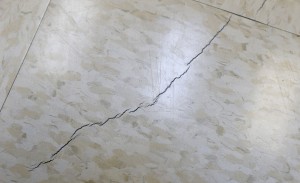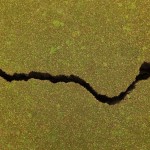Here Are 9 Studies Linking Quakes and Drilling Activity in Texas

Rodger Mallison/Fort Worth Star-Telegram/MCT
Cracks have developed in the floor and wall of the municipal courtroom in Reno, Texas, as seen Feb. 21, 2014, and some people believe it is related to the rash of earthquakes in the area.
These can be shaky times for Texas. The number of recorded earthquakes (most larger than 3.0) has increased tenfold since a drilling boom began several years ago. The Lone Star State is now one of the shakiest in the country, coming in sixth in the continuous U.S. for having larger quakes last year, according to EnergyWire.
Today, lawmakers will hold a meeting at the Capitol to look into the onset of quakes and their possible connection to oil and gas drilling. (It starts at 1 p.m. Central, and you can watch it online.)
The agenda says the House Energy Resources Subcommittee on Seismic Activity, which was formed after a swarm of quakes in North Texas that began last November, will “review the possibility that increased [oil and gas] exploration and disposal well activity could impact seismic activity.”
To see the evidence that there’s a link between that oil and gas activity and the rapid increase in earthquakes in Texas, you don’t have to look far. There’s plenty of peer-reviewed scientific studies already making a link between quakes and certain drilling activities, including wastewater disposal, oil and gas extraction, and enhanced oil recovery. While the Railroad Commission of Texas, which regulates the oil and gas industry in the state, maintains that these links are hypothetical, the number of scientific studies showing that link continue to grow.
Here’s a list of nine recent studies demonstrating a link between quakes and oil and gas activity in Texas:
- The May 17, 2012 4.8 Quake in Timpson, East Texas, Journal of Geophysical Research: A study led by Cliff Frohlich of the University of Texas at Austin found that one of the largest quakes in Texas was “possibly” triggered by oil and gas wastewater disposal wells. Two of those disposal wells were within two miles of the epicenter. The study says: “Several observations support the hypothesis that fluid injection triggered the Timpson sequence: well-located epicenters are situated near a mapped basement fault and near high-volume injection wells, focal depths are at or below the depths of injection, and the earliest preshock (April 2008) occurred after the onset of injection in 2006.”
- Two-year Survey of Earthquakes in the Eagle Ford Shale, Texas, Earth Planet: Another study led by Florich found that a series of quakes in the drilling region of South Texas (including a magnitude 4.8 in October 2011) were linked to oil and gas extraction and wastewater disposal. “In this region, while the majority of small earthquakes may be triggered/induced by human activity, they are more often associated with fluid extraction than with injection,” the study says.
- Gas injection May Have Triggered Earthquakes in the Cogdell Oil Field, Texas, Proceeding of the National Academy of Sciences: A study by Wei Gan of the China University of Geosciences and Frochlich found that the injection of carbon dioxide to enhance oil recovery in the Cogdell oil field of West Texas (north of Snyder) were likely responsible for a string of earthquakes there, including a 4.4 magnitude quake in September 2011. “If this triggered the 2006-2011 seismicity, this represents an instance where gas injection has triggered earthquakes having magnitudes 3 and larger,” the study reads. This could have implications for a strategy to deal with climate change known as carbon capture and storage, where CO2 in the atmosphere would be collected and deposited in formations underground.
- Analysis of the Cleburne, Texas, Earthquake Sequence from June 2009 to June 2010, Bulletin of the Seismological Society of America: Another study led by Frohlich of a swarm of quakes in North Texas points the finger at oil and gas wastewater disposal wells, where large volumes of dirty water left over from oil and gas drilling are disposed of deep underground. “Because there were no known previous earthquakes, and the located events were close to the two injection wells and near the injection depth, the possibility exists that earthquakes may be related to fluid injection,” the study says.
- Location for 25 April 2010 3.9 earthquake near Alice, Texas: Was it Induced by Petroleum Production? Bulletin of the Seismological Society of America: This study found that a large earthquake was likely linked to oil and gas production. “We conclude it is plausible, although not proven definitively, that production in the Stratton field contributed to the occurrence of the 2010 Alice earthquake and an earlier similar earthquake that occurred on 24 March 1997,” the report states.
- Two-year survey comparing earthquake activity and injection well locations in the Barnett Shale, Texas, Proceeding National Academy of Sciences: Another by Florich, finding that “the most significant result of this investigation is that all of the better-located epicenters were situated within a few kilometers of one or more injection wells. It is possible that some of these earthquakes have a natural origin, but it is implausible that all are natural.”
- A survey of earthquakes and injection well locations in the Barnett Shale, Texas, Leading Edge: “The data showed that virtually all well-located epicenters were situated within 3 km of high-volume injection wells.”
- The Dallas-Fort Worth earthquake sequence: October 2008 through May 2009, Bulletin of the Seismological Society of America: “Because of the absence of previous historical earthquakes, the proximity of the brine disposal well, and the similarity with other documented cases of induced seismicity, it seems likely that fluid injection induced the 2008–2009 sequence.”
- Dallas-Fort Worth earthquakes coincident with activity associated with natural gas production, Leading Edge: A series of quakes near the DFW airport “are consistent with an induced or triggered source,” in this case a disposal well that was later suspended by its owners voluntarily.
A team of scientists and researchers at Southern Methodist University is at work studying the latest Texas swarm that is centered around the towns of Reno and Azle in North Texas. It began in November 2013. Those quakes, sometimes more than a few a day, mobilized communities to call on the state to respond to the growing number of earthquakes in Texas. That group released their latest progress report Friday, finding that while larger earthquakes have ceased since late January, tremors have continued: there’s been hundreds of smaller quakes since. Two disposal wells are located near many of the quakes.
The team will present their findings to the legislature this afternoon.

